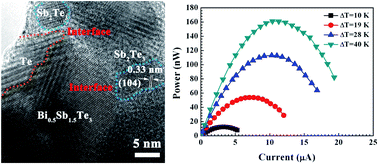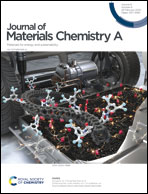Bi0.5Sb1.5Te3-based films for flexible thermoelectric devices†
Abstract
Bismuth antimony telluride (Bi0.5Sb1.5Te3)-based films have excellent thermoelectric (TE) properties at around room temperature. However, tremendous challenges remain for applying these materials in flexible TE devices due to their inherent brittleness and rigidity. Here we report the fabrication of flexible p-type Bi0.5Sb1.5Te3-based heterostructure films exhibiting optimized power factor and thermal conductivity values of ∼23.2 μW cm−1 K−2 and ∼0.8 W m−1 K−1, respectively, at 300 K. It is shown that the intrinsic TE parameters can be partially decoupled for this heterostructure system, in which new phases (Te and Sb2Te3 nanoinclusions) and numerous interfaces among Bi0.5Sb1.5Te3, Te, and Sb2Te3 are introduced. High mechanical durability and flexibility with less than 10% degradation in performance after 700 bending cycles (a bending radius of 5 mm) were achieved. Finally, a flexible TE generator assembled using these Bi0.5Sb1.5Te3-based heterostructure films and traditional n-type Bi2Te3 films exhibits a high power density of 897.8 μW cm−2 at a relatively small ΔT of 40 K. This result can provide insight into the scalable fabrication of high-performance flexible TE generators for energy harvesting.



 Please wait while we load your content...
Please wait while we load your content...